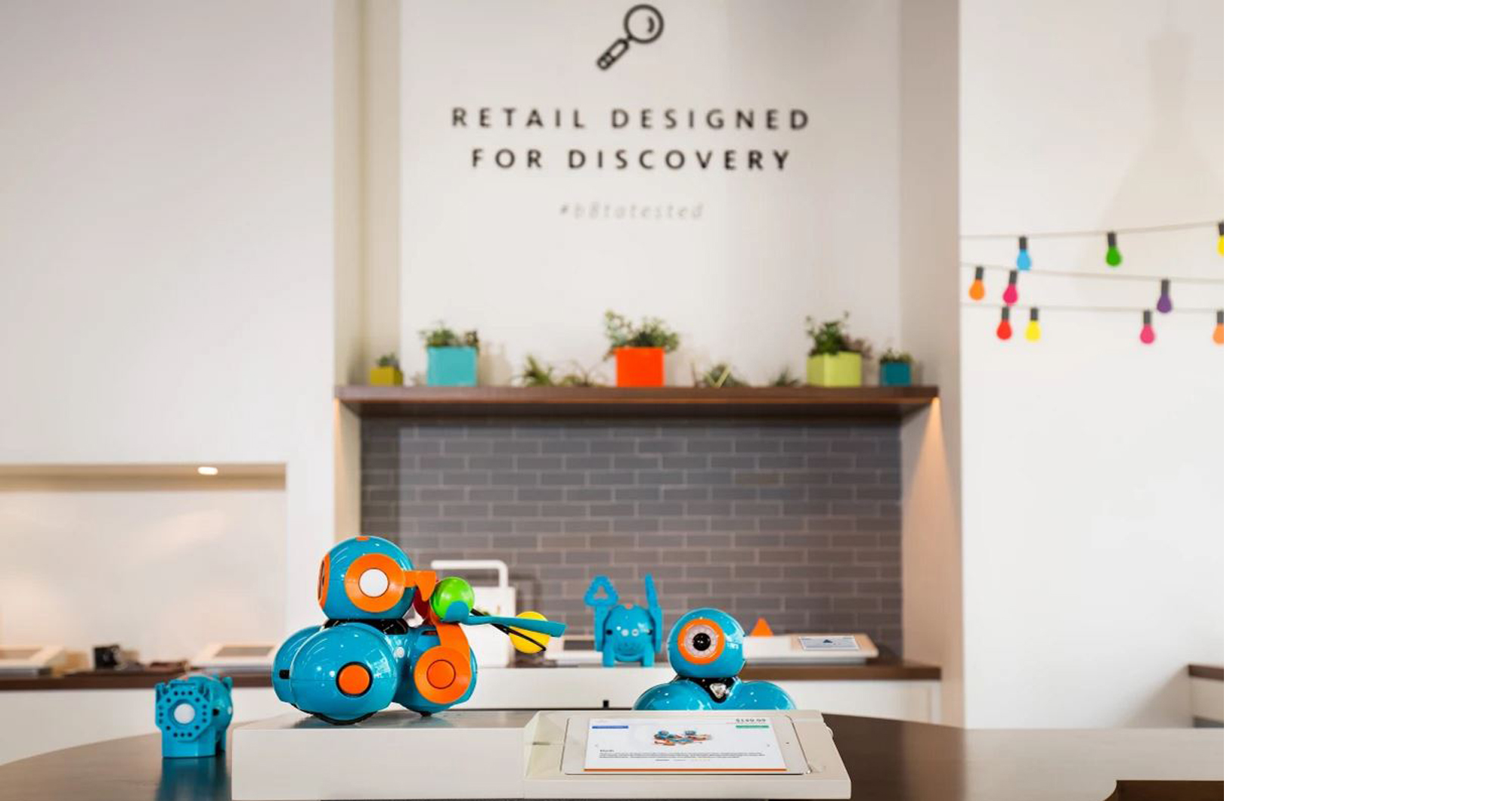Above…Interior view of b8ta, Palo Alto, California
Steve Wakeman, AIA, CSHQA Sacramento Regional Manager, and I attended the International Council of Shopping Centers’ (ICSC) Monterey conference March 9 and 10. Two excellent sessions were presented. These are my notes from Session II and as accurate as speed note taking can make them. My apologies for any errors or omissions. – KK
Test Drive This
Vibhu Norby, co-founder and CEO of b8ta, is highly conversant in high-tech and consumerism. He was part of the team that developed Nest, the home controls company recently purchased by Google for a bucket of cash. So Vibhu, who is modest, personable, focused and—my guess—also fearless, has imagined and delivered a completely new way for product manufacturers to take their goods to market. Enter b8ta, pronounced beta.
Manufacturers pay b8ta a fee to showcase their product for a period of time. Great products can renew. Not so great products—as defined by engagement rates—get sent home. Every product in b8ta is featured out of the box and comes with a digital display that manufacturers can customize to tell their product’s story. Visitors can then touch, play, and learn about whichever products interest them. Their product engagement is measured by an array of cameras that are tracking every interaction and measuring responses like dwell time. In the end, manufacturers get real-time data about how people are interacting with their products in real life, not from behind a computer or smartphone screen.
Most products at b8ta are available to buy directly in store, but if a visitor prefers to buy online, they’re encouraged to do so; any purchase stemming from a b8ta experience is considered a win for the manufacturer. Approximately 20% of b8ta products aren’t even on the market yet—they’re prototypes or new hardware featured in crowdfunding campaigns. Vibhu writes on Twitter (@vibhu) “I founded b8ta with a simple goal in mind: Create a physical space where people can try the best new technology products out of the box. No packaging—just products.”
Categories include Play (e.g. robots), Home (e.g. connected thermostats or security cameras), Sense (e.g. wearables), and Move (e.g. drones and electronic transportation). Located in the heart of downtown Palo Alto, five blocks from the Stanford Campus, b8ta is a store, of sorts, to watch. https://b8ta.com/
 These products look more like toys! at b8ta, Palo Alto, California
These products look more like toys! at b8ta, Palo Alto, California
Classic, Big Grocery is Alive and Well
Contrary to the conventional wisdom that we will soon have to choose between specialty Whole Foods-type stores and deep discounters, the big grocery store is doing fine. Steve Berndt, Western Regional VP of Safeway-Albertsons, is steadily remodeling and opening new stores. The recent purchase of Fresh & Easy adds to his mission.
The strategy – frankly – is cheaper buildings, better goods. Inside, the perishables of produce, fish and meat are high quality. (Living in Boise, the founding city of Albertsons, I can attest to that.) Bulk foods have been expanded. Layouts and finishes are more basic than previously. Concrete floors, much more natural light and less expensive fixtures are becoming the new normal. Natural, local materials are featured. More glass is used to see in and out.
A new fit for urban environments is also key. Urban stores may be just 15,000-30,000 sf compared to the newly opened San Jose store with 55,000 sf and Fuel Center. When relevant, a Starbucks or similar is added. This helps create the Third Place, an alternate to home and office or school, where customers like to hang out.
Speaking of Starbucks… Did You Know?
Leslie Mitchell of Starbucks Corporation shared that in Seattle you can have a cup of coffee that takes 40 minutes to brew. Or you can text ahead and pre-pay for an order at micro-store, currently being rolled out in Manhattan as the XP Store. The lingo is MOP, for mobile order and pay. These specially branded stores are highly experiential. Slow or fast the consumer is in charge of their experience.
Made to Order with Just In Time Funding
I’m exposing a bit of my engineering background with the phrase Just-in-Time, but it’s perfectly applicable to Taylor Stitch, a custom shirt and accessories maker. The online store offers a special model, with cut and fabric, in a limited edition. Clients place orders and make payments, and when the payments reach a certain level the fabric is purchased and the products are made – to order. www.taylorstitch.com.
If Taylor Stitch represents the blending of craftsmen and artisans with digital commerce, retail developer and Taylor Stitch investor Matt Holmes, Principal of Retail West, represents a blend of patron and venture capitalist. He has been in retail development for many years, owns a variety of properties, and has seen retailers come and go. His philosophy regarding start-ups is that they need some help, someone to believe in them. And when they succeed he benefits both as a landlord and investor. My sense that his satisfaction as a human being is even greater.
Matt is also blending manufacturing with retail in Makers Market, a store for micro and small retailers to produce and sell their goods in one store. His online bio is fun and quirky. One of the most interesting I have read. www.retailwestinc.com
As moderator James Cook of JLL, a Fortune 500 investment management company, quipped “Retail has changed under our feet!”